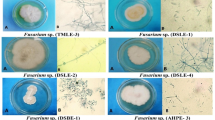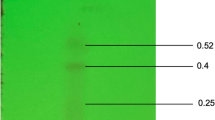Abstract
A fungal endophyte identified as Fusarium sp. Tlau3 was isolated from fresh twig of Thunbergia laurifolia Lindl., a Thai medicinal plant collected from the forest of Chiang Mai Province, Northern Thailand. The fungus was grown on a medium containing yeast extracts and sucrose. The fungal metabolites were isolated from the culture broth by dichloromethane extraction, isooctane/methanol then n-butanol/water partitions, and fractionation with Sephadex LH 20 column chromatography. Acanthamoebicidal fractions were found to induce the formation of large contractile vacuole (LCV) in trophozoites of an Acanthamoeba clinical isolate, leading to cell lysis under isotonic and hypotonic conditions within 1 h. In hypertonic condition, LCV formation was also induced but without cell lysis. Acridine orange staining of the treated cells revealed increased intracellular acidity, implying an increased proton pumping or a vacuolar proton-ATPase (V-ATPase) stimulation. Scanning electron microscopy showed cell membrane damage with intact cytoplasmic organelles. Our finding has indicated that contractile vacuoles of Acanthamoeba trophozoites are the primary target of the amoebicidal substance(s) from this endophytic fungus.







Similar content being viewed by others
References
Alizadeh H, Silvany RE, Meyer DR, Dougherty JM, McCulley JP (1997) In vitro amoebicidal activity of propamidine and pentamidine isethionate against Acanthamoeba species and toxicity to corneal tissues. Cornea 16:94–100
Allen RD, Naitoh Y (2002) Osmoregulation and contractile vacuoles of protozoa. Int Rev Cytol 215:351–394
Altschul SF, Madden TL, Schäffer AA, Zhang J, Zhang Z, Miller W, Lipman DJ (1997) Gapped BLAST and PSI-BLAST: a new generation of protein database search programs. Nucleic Acids Res 25:3389–3402
Becker B, Hickisch A (2005) Inhibition of contractile vacuole function by brefeldin A. Plant Cell Physiol 46:201–212
Berk SG, Ting RS, Turner GW, Ashburn RJ (1998) Production of respirable vesicles containing live Legionella pneumophila cells by two Acanthamoeba spp. Appl Environ Microbiol 64:279–286
Biddick CJ, Rogers LH, Brown TJ (1984) Viability of pathogenic and nonpathogenic free-living amoebae in long-term storage at a range of temperatures. Appl Environ Microbiol 48:859–860
Bozzola JJ, Russell LD (1999) Electron microscopy: principles and techniques for biologist, 2nd edn. Jones and Bartlett, Sudbury MA, pp 48–71
Chomcheon P, Wiyakrutta S, Sriubolmas N, Ngamrojanavanich N, Isarangkul D, Kittakoop P (2005) 3-Nitropropionic acid (3-NPA), a potent antimycobacterial agent from endophytic fungi: is 3-NPA in some plants produced by endophytes? J Nat Prod 68:1103–1105
Chu DM, Miles H, Toney D, Ngyuen C, Marciano-Cabral F (1998) Amebicidal activity of plant extracts from Southeast Asia on Acanthamoeba spp. Parasitol Res 84:746–752
Chusattayanond Dharmkrong-at A, Paveenkittiporn W, Dejsirilert S, Suchaoin S (2001) Demonstration of serogroup-6 Legionella pneumophila in soil acanthamoebae. Proceedings of the IXth International Meeting on the Biology and Pathogenicity of Free-living Amoebae, Paris, 8–14 July, pp 151–154
Doberstein SK, Baines IC, Wiegand G, Korn ED, Pollard TD (1993) Inhibition of contractile vacuole function in vivo by antibodies against myosin. Nature 365:841–843
Duguid IG, Dart JK, Morlet N, Allan BD, Matheson M, Ficker L, Tuft S (1997) Outcome of Acanthamoeba keratitis treated with polyhexamethyl biguanide and propamidine. Ophthalmology 104:1587–1592
Ficker L, Seal D, Warhurst D, Wright P (1990) Acanthamoeba keratitis—resistance to medical therapy. Eye 4:835–838
Inglis T, Rigby P, Robertson T, Dutton N, Henderson M, Chang B (2000) Interaction between Burkholderia pseudomallei and Acanthamoeba species results in coiling phagocytosis, endamebic bacterial survival, and escape. Infect Immun 68(3):1681–1686
Ji-Eun L, Boo Sup O, Hee Young C, Hak Sun Y, Jong Soo L (2007) Cysticidal effect on Acanthamoeba and toxicity on human keratocytes by polyhexamethylene biguanide and chlorhexidine. Cornea 26:736–741
Lloyd D, Turner NA, Khunkitti W, Hann AC, Furr JR, Russell AD (2001) Encystation in Acanthamoeba castellanii: development of biocide resistance. J Eukaryot Microbiol 48:11–16
Martinez AJ (1991) Infections of the central nervous system due to Acanthamoeba. Rev Infect Dis 13:S399–S402
Mattana A, Biancu G, Alberti L, Accardo A, Delogu G, Fiori PL, Cappuccinelli P (2004) In vitro evaluation of the effectiveness of the macrolide rokitamycin and chlorpromazine against Acanthamoeba castellanii. Antimicrob Agents Chemother 48:4520–4527
Mergeryan H (1991) The prevalence of Acanthamoeba in the human environment. Rev Infect Dis 13:410–412
Michel R, Burghardt H, Bergmann H (1995) Acanthamoeba, naturally intracellularly infected with Pseudomonas aeruginosa, after their isolation from a microbiologically contaminated drinking water system in a hospital. Zentralbl Hyg Umweltmed 196:532–544
Miltner EC, Bermudez LE (2000) Mycobacterium avium grown in Acanthamoeba castellanii is protected from the effects of antimicrobials. Antimicrob Agents Chemother 44:1990–1994
Murakawa GJ, McCalmont T, Altman J, Telang GH, Hoffman MD, Kantor GR, Berger TG (1995) Disseminated acanthamebiasis in patients with AIDS. A report of five cases and a review of the literature. Arch Dermatol 131:1291–1296
Murdoch D, Gray TB, Cursons R, Parr D (1998) Acanthamoeba keratitis in New Zealand, including two cases with in vivo resistance to polyhexamethylene biguanide. Aust N Z J Ophthalmol 26:231–236
Osato MS, Robinson NM, Wilhelmus KR, Jones DB (1991) In vitro evaluation of antimicrobial compounds for cysticidal activity against Acanthamoeba. Rev Infect Dis 13(Suppl. 5):S431–435
Pussard M, Pons R (1977) Morphologies de la paroi kystique et taxonomie du genre Acanthamoeba (Protozoa, Amoebida). Protistologica 13:557–610
Riddick DH (1968) Contractile vacuole in the amoeba Pelomyxa carolinensis. Am J Physiol 215:736–740
Rodriguez-Zaragoza S (1994) Ecology of free-living amoebae. Crit Rev Microbiol 20:225–241
Schuster FL, Visvesvara GS (1998) Efficacy of novel antimicrobials against clinical isolates of opportunistic amebas. J Eukaryot Microbiol 45:612–618
Seal DV, Hay J (1994) Acanthamoeba keratitis. Br Med J 309:1019
Seal DV, Hay J, Kirkness CM (1995) Chlorhexidine or polyhexamethylene biguanide for Acanthamoeba keratitis. Lancet 345:136
Stock C, Gronlien HK, Allen RD, Naitoh Y (2002) Osmoregulation in Paramecium: in situ ion gradients permit water to cascade through the cytosol to the contractile vacuole. J Cell Sci 115:2339–2348
Strobel GA, Daisy B, Castillo U, Harper JK (2004) Natural products from endophytic microorganisms. J Nat Prod 67:257–268
Swofford DL (2003) PAUP*: phylogenetic analysis using parsimony (*and other methods) version 4. Sinauer, Sunderland, MA
Tan RX, Zou WX (2001) Endophytes: a rich source of functional metabolites. Nat Prod Rep 18:448–459
Thompson JD, Higgins DG, Gibson TJ (1994) CLUSTAL W: improving the sensitivity of progressive multiple sequence alignment through sequence weighting, position-specific gap penalties and weight matrix choice. Nucleic Acids Res 22:4673–4680
Walochnik J, Duchêne M, Seifert K, Obwaller A, Hottkowitz T, Wiederman G, Eibl H, Aspöck H (2002) Cytotoxic activities of alkylphosphocholines against clinical isolates of Acanthamoeba spp. Antimicrob Agents Chemother 46:695–701
Weisman RA (1976) Differentiation in Acanthamoeba castellanii. Annu Rev Microbiol 30:189–219
White TJ, Bruns T, Lee S, Taylor J (1990) Amplification and direct sequencing of fungal ribosomal RNA genes for phylogenetics. In: Innis MA, Gelfand DH, Sninsky JJ, White TJ (eds) PCR protocols: a guide to methods and applications. Academic, San Diego, pp 315–322
Wiyakrutta S, Sriubolmas N, Panphut W, Thongon N, Danwisetkanjana K, Nijsiri Reungrungsi N, Meevootisom V (2004) Endophytic fungi with anti-microbial, anti-cancer and anti-malarial activities isolated from Thai medicinal plants. World J Microbiol Biotechnol 20:265–272
Acknowledgement
We thank Dr. Yutaka Sagara for editing this manuscript. This research was supported in part by the Department of Microbiology, Faculty of Science, Mahidol University, Bangkok, Thailand. We also thank the Center of Nanoimaging, Faculty of Science, Mahidol University for technical assistance in electron microscopy.
Author information
Authors and Affiliations
Corresponding author
Rights and permissions
About this article
Cite this article
Boonman, N., Wiyakrutta, S., Sriubolmas, N. et al. Acanthamoebicidal activity of Fusarium sp. Tlau3, an endophytic fungus from Thunbergia laurifolia Lindl.. Parasitol Res 103, 1083–1090 (2008). https://doi.org/10.1007/s00436-008-1096-z
Received:
Accepted:
Published:
Issue Date:
DOI: https://doi.org/10.1007/s00436-008-1096-z




